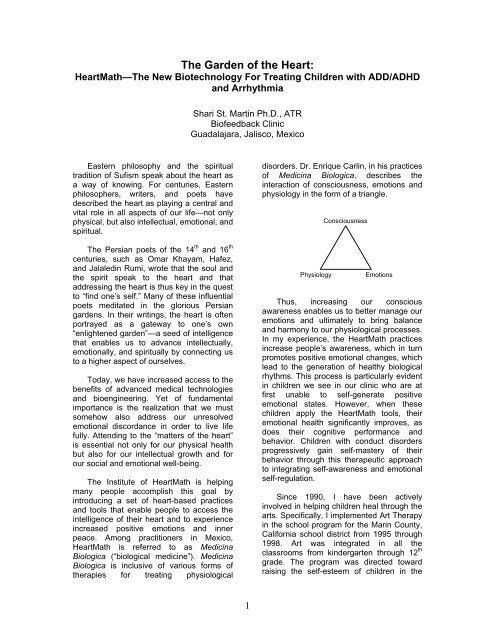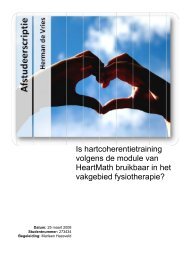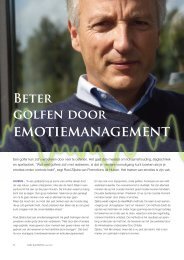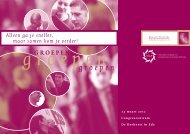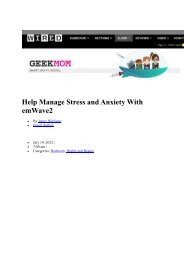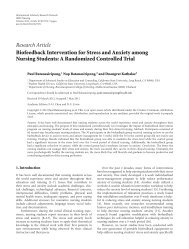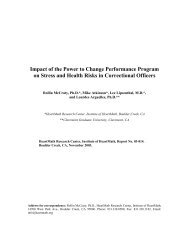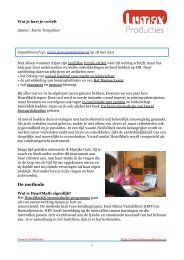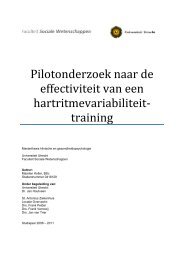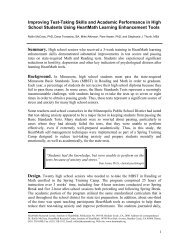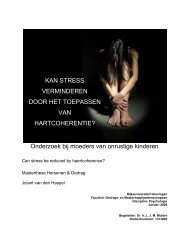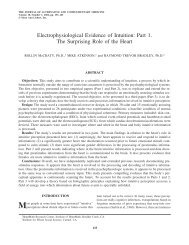The Garden of the Heart: - Heartmath Benelux
The Garden of the Heart: - Heartmath Benelux
The Garden of the Heart: - Heartmath Benelux
You also want an ePaper? Increase the reach of your titles
YUMPU automatically turns print PDFs into web optimized ePapers that Google loves.
<strong>The</strong> <strong>Garden</strong> <strong>of</strong> <strong>the</strong> <strong>Heart</strong>:<br />
<strong>Heart</strong>Math—<strong>The</strong> New Biotechnology For Treating Children with ADD/ADHD<br />
and Arrhythmia<br />
Shari St. Martin Ph.D., ATR<br />
Bi<strong>of</strong>eedback Clinic<br />
Guadalajara, Jalisco, Mexico<br />
Eastern philosophy and <strong>the</strong> spiritual<br />
tradition <strong>of</strong> Sufism speak about <strong>the</strong> heart as<br />
a way <strong>of</strong> knowing. For centuries, Eastern<br />
philosophers, writers, and poets have<br />
described <strong>the</strong> heart as playing a central and<br />
vital role in all aspects <strong>of</strong> our life—not only<br />
physical, but also intellectual, emotional, and<br />
spiritual.<br />
<strong>The</strong> Persian poets <strong>of</strong> <strong>the</strong> 14 th and 16 th<br />
centuries, such as Omar Khayam, Hafez,<br />
and Jalaledin Rumi, wrote that <strong>the</strong> soul and<br />
<strong>the</strong> spirit speak to <strong>the</strong> heart and that<br />
addressing <strong>the</strong> heart is thus key in <strong>the</strong> quest<br />
to “find one’s self.” Many <strong>of</strong> <strong>the</strong>se influential<br />
poets meditated in <strong>the</strong> glorious Persian<br />
gardens. In <strong>the</strong>ir writings, <strong>the</strong> heart is <strong>of</strong>ten<br />
portrayed as a gateway to one’s own<br />
“enlightened garden”—a seed <strong>of</strong> intelligence<br />
that enables us to advance intellectually,<br />
emotionally, and spiritually by connecting us<br />
to a higher aspect <strong>of</strong> ourselves.<br />
Today, we have increased access to <strong>the</strong><br />
benefits <strong>of</strong> advanced medical technologies<br />
and bioengineering. Yet <strong>of</strong> fundamental<br />
importance is <strong>the</strong> realization that we must<br />
somehow also address our unresolved<br />
emotional discordance in order to live life<br />
fully. Attending to <strong>the</strong> “matters <strong>of</strong> <strong>the</strong> heart”<br />
is essential not only for our physical health<br />
but also for our intellectual growth and for<br />
our social and emotional well-being.<br />
<strong>The</strong> Institute <strong>of</strong> <strong>Heart</strong>Math is helping<br />
many people accomplish this goal by<br />
introducing a set <strong>of</strong> heart-based practices<br />
and tools that enable people to access <strong>the</strong><br />
intelligence <strong>of</strong> <strong>the</strong>ir heart and to experience<br />
increased positive emotions and inner<br />
peace. Among practitioners in Mexico,<br />
<strong>Heart</strong>Math is referred to as Medicina<br />
Biologica (“biological medicine”). Medicina<br />
Biologica is inclusive <strong>of</strong> various forms <strong>of</strong><br />
<strong>the</strong>rapies for treating physiological<br />
disorders. Dr. Enrique Carlin, in his practices<br />
<strong>of</strong> Medicina Biologica, describes <strong>the</strong><br />
interaction <strong>of</strong> consciousness, emotions and<br />
physiology in <strong>the</strong> form <strong>of</strong> a triangle.<br />
Physiology<br />
Consciousness<br />
Emotions<br />
Thus, increasing our conscious<br />
awareness enables us to better manage our<br />
emotions and ultimately to bring balance<br />
and harmony to our physiological processes.<br />
In my experience, <strong>the</strong> <strong>Heart</strong>Math practices<br />
increase people’s awareness, which in turn<br />
promotes positive emotional changes, which<br />
lead to <strong>the</strong> generation <strong>of</strong> healthy biological<br />
rhythms. This process is particularly evident<br />
in children we see in our clinic who are at<br />
first unable to self-generate positive<br />
emotional states. However, when <strong>the</strong>se<br />
children apply <strong>the</strong> <strong>Heart</strong>Math tools, <strong>the</strong>ir<br />
emotional health significantly improves, as<br />
does <strong>the</strong>ir cognitive performance and<br />
behavior. Children with conduct disorders<br />
progressively gain self-mastery <strong>of</strong> <strong>the</strong>ir<br />
behavior through this <strong>the</strong>rapeutic approach<br />
to integrating self-awareness and emotional<br />
self-regulation.<br />
Since 1990, I have been actively<br />
involved in helping children heal through <strong>the</strong><br />
arts. Specifically, I implemented Art <strong>The</strong>rapy<br />
in <strong>the</strong> school program for <strong>the</strong> Marin County,<br />
California school district from 1995 through<br />
1998. Art was integrated in all <strong>the</strong><br />
classrooms from kindergarten through 12 th<br />
grade. <strong>The</strong> program was directed toward<br />
raising <strong>the</strong> self-esteem <strong>of</strong> children in <strong>the</strong><br />
1
schools. It also addressed different styles <strong>of</strong><br />
learning—visual, auditory, kines<strong>the</strong>tic,<br />
olfactory, and verbal. My co-educators and I<br />
also worked with <strong>the</strong> Autodesk Foundation,<br />
integrating biotechnology as part <strong>of</strong> <strong>the</strong>ir<br />
healing processes. Using body images,<br />
painting and photography, <strong>the</strong> children were<br />
able to improve <strong>the</strong>ir self-image and to<br />
increase <strong>the</strong>ir awareness.<br />
Just as Art <strong>The</strong>rapy was a way <strong>of</strong><br />
helping young people connect <strong>the</strong> mind and<br />
body through a nonverbal language, <strong>the</strong><br />
<strong>Heart</strong>Math approach is helping children<br />
connect <strong>the</strong>ir hearts and minds using<br />
bi<strong>of</strong>eedback technology to facilitate <strong>the</strong><br />
process.<br />
I had <strong>the</strong> opportunity to teach in Mexico<br />
through <strong>the</strong> international exchange teaching<br />
program that was <strong>of</strong>fered through Sonoma<br />
State University. I worked in Guadalajara for<br />
a program sponsored by <strong>the</strong> University <strong>of</strong><br />
Guadalajara. Here I introduced <strong>the</strong> same<br />
programs as I did in <strong>the</strong> Marin County<br />
schools with special sobresalientes (highintelligence)<br />
children who also had attentiondeficit<br />
disorder or attention-deficit<br />
hyperactivity disorder (ADD/ADHD). In 2001,<br />
I first used <strong>Heart</strong>Math’s Freeze-Framer ∗ to<br />
aid in teaching <strong>the</strong> <strong>Heart</strong>Math tools to <strong>the</strong>se<br />
children.<br />
Because <strong>of</strong> a great need, I later opened<br />
a clinic in Guadalajara to help treat children<br />
with attention-deficit disorder. At this clinic I<br />
was able to use <strong>the</strong> <strong>Heart</strong>Math tools and<br />
technology in treating many children with<br />
ADD/ADHD, ranging from 6 to 18 years in<br />
age. By using <strong>the</strong> Freeze-Framer heart<br />
rhythm coherence feedback system with<br />
<strong>the</strong>m, I made a surprising discovery: <strong>the</strong><br />
heart rhythm data indicated that <strong>the</strong> majority<br />
<strong>of</strong> <strong>the</strong>se children were suffering from cardiac<br />
arrhythmia.<br />
∗ <strong>The</strong> Freeze-Framer is a heart rate variability feedback<br />
system that monitors heart rhythm patterns in real time<br />
and objectively quantifies a beneficial state known as<br />
psychophysiological coherence. <strong>The</strong> coherence level is<br />
fed back to <strong>the</strong> user as an accumulated score or<br />
success in playing one <strong>of</strong> three interactive games<br />
designed to reinforce emotion-refocusing skills. <strong>The</strong><br />
system also includes a tutorial in <strong>the</strong> <strong>Heart</strong>Math positive<br />
emotion-based coherence-building techniques.<br />
<strong>The</strong>se findings were verified by a local<br />
cardiologist, Dr. Hector M. Briseño Ramirez,<br />
who has been working closely with me in my<br />
clinic. <strong>The</strong> discovery <strong>of</strong> cardiac arrhythmia in<br />
<strong>the</strong> majority <strong>of</strong> <strong>the</strong> children we see in my<br />
clinic was an extremely important finding, as<br />
it pointed to a clear psychophysiological<br />
factor that could contribute to <strong>the</strong><br />
manifestation <strong>of</strong> <strong>the</strong> symptoms <strong>of</strong><br />
ADD/ADHD.<br />
When I started working with <strong>the</strong><br />
<strong>Heart</strong>Math program, I used <strong>the</strong> following<br />
protocol. After every heart rhythm feedback<br />
training session, I set <strong>the</strong> child up to do <strong>the</strong><br />
very effective exercises included in <strong>the</strong><br />
Freeze-Framer program. I also introduced<br />
<strong>the</strong>m to <strong>the</strong> Balloon Game, <strong>the</strong> Rainbow<br />
Game, and <strong>the</strong> Meadow Game. <strong>The</strong><br />
responses were sometimes challenging<br />
because <strong>the</strong> children would have to work<br />
with <strong>the</strong>ir feelings and emotions, something<br />
<strong>the</strong>y were not accustomed to; however, <strong>the</strong>y<br />
quickly grew to feel that <strong>the</strong>y had a safe<br />
place in which to practice <strong>the</strong> exercises<br />
without judgment. <strong>The</strong> children soon felt free<br />
to move <strong>the</strong> balloon or <strong>the</strong> rainbow or to<br />
color <strong>the</strong> meadow by just feeling or tapping<br />
into <strong>the</strong>ir emotions. Fear <strong>of</strong> judgment was<br />
not at issue, since <strong>the</strong> images <strong>the</strong>y produced<br />
simply spoke to <strong>the</strong>m about how <strong>the</strong>y felt. It<br />
was especially empowering when <strong>the</strong>y were<br />
able to complete one <strong>of</strong> <strong>the</strong> games<br />
successfully and <strong>the</strong>n view <strong>the</strong>ir heart<br />
rhythm coherence scores, which showed a<br />
stable and highly coherent heart rhythm.<br />
Being able to create <strong>the</strong> images on <strong>the</strong><br />
screen through <strong>the</strong>ir own emotional<br />
management skills and improving <strong>the</strong>ir heart<br />
rhythm coherence scores each time gave<br />
<strong>the</strong> children a sense <strong>of</strong> high self-esteem and<br />
generated feelings <strong>of</strong> self-empowerment.<br />
In Guadalajara, since 2001, I have used<br />
<strong>the</strong> <strong>Heart</strong>Math technology in <strong>the</strong> successful<br />
treatment <strong>of</strong> 396 children with ADD/ADHD. I<br />
have evaluated <strong>the</strong> improvements in <strong>the</strong><br />
children’s ability to self-regulate <strong>the</strong>ir<br />
emotions by using <strong>the</strong>se remarkable tools. I<br />
have found that <strong>the</strong> <strong>Heart</strong>Math tools and<br />
technologies correct cardiac arrhythmia,<br />
elevate children’s self esteem, and bring<br />
about mastery in self-regulation. <strong>The</strong><br />
improvements gained though <strong>the</strong> use <strong>of</strong><br />
<strong>the</strong>se interventions are so pr<strong>of</strong>ound that <strong>the</strong>y<br />
have eliminated <strong>the</strong> need for ADHD-related<br />
2
medications in <strong>the</strong> vast majority <strong>of</strong> <strong>the</strong><br />
children I have treated.<br />
One example <strong>of</strong> <strong>the</strong> types <strong>of</strong> changes I<br />
have observed is illustrated by <strong>the</strong> following<br />
typical case <strong>of</strong> an 8-year-old boy. Similar to<br />
many <strong>of</strong> our cases, this boy struggled with<br />
conduct disorder and hyperactivity. This<br />
child also had an arrhythmia, as do many <strong>of</strong><br />
<strong>the</strong> children we see. His mo<strong>the</strong>r had shared<br />
with us her disappointment and frustration<br />
with his stealing, lying, and passiveaggressive<br />
behavior as well as his diagnosis<br />
<strong>of</strong> ADHD.<br />
After <strong>the</strong> ninth session <strong>of</strong> working with<br />
this child with <strong>the</strong> <strong>Heart</strong>Math tools and <strong>the</strong><br />
Freeze-Framer, <strong>the</strong> boy’s mo<strong>the</strong>r reported<br />
that <strong>the</strong>re was no more lying or stealing and<br />
that her son had changed drastically. He<br />
was more sociable and more compassionate<br />
toward his parents and o<strong>the</strong>rs. His academic<br />
scores had also significantly improved and<br />
he felt much more relaxed and secure about<br />
himself. One day, after his verbal <strong>the</strong>rapy<br />
session in our clinic, <strong>the</strong> child came over to<br />
me and gave me a kiss to say thank you. I<br />
presumed this was for introducing<br />
<strong>Heart</strong>Math to him.<br />
It is interesting to note that this boy’s<br />
records indicated no biological basis for his<br />
symptoms <strong>of</strong> ADHD. However, our finding <strong>of</strong><br />
his cardiac arrhythmia suggested that <strong>the</strong>se<br />
irregularities in his heart rhythm may in fact<br />
have been an important physiological factor<br />
contributing to his ADHD symptoms.<br />
To appreciate <strong>the</strong> significance <strong>of</strong> this, it<br />
is important to realize that ADHD is most<br />
commonly viewed as an environmentallybased<br />
condition that is not associated with<br />
any underlying biological disorder. This<br />
perspective, espoused by <strong>the</strong> American<br />
Psychiatric Association in its diagnostic<br />
criteria from DSM-IV, is maintained by many<br />
researchers and clinicians (Maté, 1999; St.<br />
Martin, 2004). My own research on one<br />
thousand cases, conducted from 1995<br />
through 1998 in <strong>the</strong> Marin County schools,<br />
also supported this view. My overall findings<br />
were that <strong>the</strong> children enrolled in <strong>the</strong> Art<br />
<strong>The</strong>rapy program in <strong>the</strong>se schools did not<br />
present biological disorders that could<br />
potentially be generative factors in <strong>the</strong>ir<br />
ADHD. Instead, <strong>the</strong> main causes appeared<br />
to be emotional factors related to issues<br />
such as family separation, loss <strong>of</strong> kin,<br />
divorce, and a chaotic lifestyle. My research<br />
also showed that <strong>the</strong>se children responded<br />
to an intervention that integrated art/imagery<br />
and creativity into <strong>the</strong> main curriculum. This<br />
approach appeared to move <strong>the</strong> children<br />
toward a calmer state <strong>of</strong> consciousness.<br />
Indeed, it has become increasingly apparent<br />
that addressing <strong>the</strong> state <strong>of</strong> consciousness<br />
and emotion is a big part <strong>of</strong> healing children<br />
with a wide variety <strong>of</strong> psychosomatic<br />
disorders, including asthma, Reynaud’s<br />
syndrome, tension headache, allergies,<br />
enuresis, neurodermatitis, obesity, and, as<br />
evident from my recent findings, arrhythmia.<br />
Thus, my work in Guadalajara propelled me<br />
to expand my previous view <strong>of</strong> ADD/ADHD<br />
as a disorder <strong>of</strong> primarily environmental<br />
origin. As I began to investigate<br />
physiological disorders in children with<br />
ADHD, it became clear that arrhythmia was<br />
a significant physiological factor in <strong>the</strong><br />
majority <strong>of</strong> our cases here in Mexico.<br />
<strong>Heart</strong> rhythm coherence feedback<br />
training addresses <strong>the</strong> regulation <strong>of</strong> <strong>the</strong><br />
heart by both <strong>the</strong> sympa<strong>the</strong>tic and<br />
parasympa<strong>the</strong>tic branches <strong>of</strong> <strong>the</strong> autonomic<br />
nervous system. <strong>The</strong> heart’s rhythmic<br />
activity continually reflects heart–brain<br />
interactions and autonomic nervous system<br />
dynamics. <strong>The</strong> <strong>Heart</strong>Math tools and<br />
technologies help to establish heart rhythm<br />
coherence as a familiar and accessible<br />
state, <strong>the</strong>reby changing <strong>the</strong> messages<br />
traveling between <strong>the</strong> heart and brain,<br />
stabilizing nervous system dynamics, and<br />
increasing emotional stability. Using<br />
<strong>Heart</strong>Math in treating children with<br />
ADD/ADHD became a golden key for us,<br />
yielding remarkable results across <strong>the</strong><br />
physiological, emotional, and behavioral<br />
dimensions.<br />
Figures 1 through 3 show <strong>the</strong> progress<br />
made by a 10-year-old boy with ADHD in<br />
learning to self-generate a coherent heart<br />
rhythm using <strong>the</strong> <strong>Heart</strong>Math tools and <strong>the</strong><br />
Freeze-Framer system. <strong>The</strong> charts are<br />
actual records from <strong>the</strong> child’s Freeze-<br />
Framer practice across 12 treatment<br />
sessions (several practice sessions on <strong>the</strong><br />
Freeze-Framer are completed in each<br />
treatment session). <strong>The</strong> top chart on each<br />
panel plots <strong>the</strong> boy’s average heart rate for<br />
3
each Freeze-Framer practice session, while<br />
<strong>the</strong> bottom chart shows his heart rhythm<br />
coherence ratio (each vertical bar<br />
represents one Freeze-Framer practice<br />
session, with red representing <strong>the</strong><br />
percentage <strong>of</strong> <strong>the</strong> session spent in low<br />
coherence, blue representing medium<br />
coherence, and green representing high<br />
coherence).<br />
At entry level (treatment sessions 1<br />
through 5, shown in Figure 1), this child<br />
demonstrated considerable variability in<br />
average heart rate across sequential<br />
Freeze-Framer practice sessions, with heart<br />
rate spiking extremely high in two <strong>of</strong> <strong>the</strong><br />
sessions. In about half <strong>the</strong> Freeze-Framer<br />
practice sessions shown in this panel, <strong>the</strong><br />
boy’s heart rhythm remained in <strong>the</strong> “low<br />
coherence” range throughout nearly <strong>the</strong><br />
entire session. However, in <strong>the</strong> o<strong>the</strong>r half <strong>of</strong><br />
<strong>the</strong> sessions, <strong>the</strong> child was able to generate<br />
some medium coherence and even a small<br />
amount <strong>of</strong> high heart rhythm coherence.<br />
Figure 2. Sessions 6–9<br />
Finally, in Figure 3 (treatment sessions<br />
10 through 12) we see that this child’s<br />
average heart rate has decreased even<br />
fur<strong>the</strong>r and has become very stable from<br />
session to session (note that <strong>the</strong>re are no<br />
extreme spikes in this record). His ability to<br />
generate medium to high heart rhythm<br />
coherence has increased substantially,<br />
indicating increased nervous system<br />
stabilization and increased synchronization<br />
and harmony in <strong>the</strong> activity <strong>of</strong> <strong>the</strong> heart,<br />
brain, and o<strong>the</strong>r bodily processes. Of<br />
particular note is <strong>the</strong> fact that this child had a<br />
cardiac arrhythmia at <strong>the</strong> beginning <strong>of</strong> <strong>the</strong><br />
training program, which was no longer<br />
present at <strong>the</strong> end <strong>of</strong> <strong>the</strong> sessions; this was<br />
confirmed by cardiologist Dr. Hector<br />
Briseño.<br />
Figure 1. Sessions 1–5<br />
Figure 2 (treatment sessions 6 through 9)<br />
shows a move towards increased<br />
coherence. Overall, <strong>the</strong> boy’s average heart<br />
rate across <strong>the</strong> sessions has dropped<br />
considerably, although <strong>the</strong>re is still one<br />
session in which he displays an extremely<br />
high heart rate. In about three-quarters <strong>of</strong><br />
<strong>the</strong> sessions shown, he is now able to<br />
achieve between 25–75% medium to high<br />
coherence; and his ratio <strong>of</strong> high heart<br />
rhythm coherence (green segments) has<br />
also increased.<br />
Figure 3. Sessions 10–12<br />
In sum, from our work in our bi<strong>of</strong>eedback<br />
clinic in Guadalajara, Jalisco, Mexico, we<br />
have reached <strong>the</strong> conclusion that<br />
<strong>Heart</strong>Math’s Freeze-Framer is one <strong>of</strong> <strong>the</strong><br />
most promising biotechnologies <strong>of</strong> <strong>the</strong> new<br />
millennium for treating ADHD and many<br />
psychosomatic disorders.<br />
4
For more information on <strong>the</strong> Institute <strong>of</strong><br />
<strong>Heart</strong>Math, research publications, and <strong>the</strong><br />
Freeze-Framer heart rhythm coherence<br />
feedback system, visit www.heartmath.org.<br />
Bibliography<br />
Gardner, H. (1978). Developing <strong>the</strong> spectrum <strong>of</strong><br />
human intelligence. Harvard Educational Review<br />
57(2), 187-193.<br />
Maté, G. (1999). Scattered minds: A new look at<br />
<strong>the</strong> origins and healing <strong>of</strong> attention deficit<br />
disorder. Toronto: Vintage Canada.<br />
Mindell, A. (1982). Dreambody: <strong>The</strong> body’s role<br />
in revealing <strong>the</strong> self. Boston: Sigo Press.<br />
Reasoner, R. (1982). Building self-esteem: A<br />
teacher’s guide and classroom materials. Palo<br />
Alto, CA: Consulting Psychologists Press.<br />
St. Martin, S. (1995). Integrating art and<br />
technology. Paper presented at <strong>the</strong> Third<br />
Midwinter Conference on Project-Based<br />
Learning, Autodesk Foundation Intern Program,<br />
San Rafael, CA.<br />
St. Martin, S. (1995). <strong>The</strong> conscious and <strong>the</strong><br />
unconscious mind. Masters <strong>The</strong>sis, Sonoma<br />
State University, Sonoma, CA.<br />
St. Martin, S. (1995). <strong>The</strong> healing power <strong>of</strong><br />
imagery: Listening to children’s voices through<br />
<strong>the</strong> images <strong>the</strong>y create. San Rafael, CA:<br />
Autodesk Foundation Press.<br />
St. Martin, S. (1998). Art <strong>the</strong>rapy in <strong>the</strong> schools –<br />
Program Marin County: A manual for <strong>the</strong> Novato<br />
schools. American Association <strong>of</strong> University<br />
Women, Community University Action Projects.<br />
St. Martin, S. (2004). Porque el déficit de<br />
atención en los niños. Developed and published<br />
by Fondos Cultural Economico, Guadalajara,<br />
Jalisco, Mexico.<br />
St. Martin, S., & Morgan, J. (1996). Enhancing<br />
learning through relevance. Paper presented at<br />
<strong>the</strong> Fourth Midwinter Conference on Project-<br />
Based Learning, Autodesk Foundation Intern<br />
Program, San Rafael, CA.<br />
5


